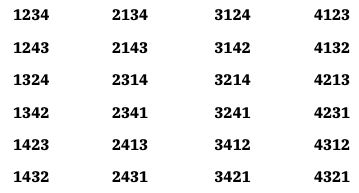How Can I Get My Fingers To Move Faster?
This is a question I get every once in a while from one of my students. Speed is the byproduct of accuracy. The lesser your fingers move, the faster you’ll be able to move them.
The fingers of the fretting hand are numbered:
1 = pointer finger
2 = middle finger
3 = ring finger
4 = pinky
When you place your fingers on four adjacent frets, and you play every note only once, then you have twenty-four possible finger combinations.
Here they are:

The Ultimate Accuracy Drill
- Alternate pick everything.
- Play the four-note finger combination of your choice, on the low E string, starting on the first fret.
- Move only one finger at a time. Force your other fingers to stay completely still and very close to the fretboard.
- After you have played a note, gently lift that finger up again. Keep it close to the fretboard. Play the next note, and so on.
- Play slowly. After you have played all four notes/fingers, move on to the A string, and play the same combination, then again on the D string, and so on, without any pause. Try to make all notes perfectly even in length, loudness, and sound quality.
- After you have played the four-note combination all the way up to the high E string, move up one fret, and play it again on the high E string. (But now one fret higher).
- From there on, keep doing the same finger combination, on the B string, G string, etc. (now moving back to the low E string, one string at a time, with no pause between string changes).
- When you reach the low E string, play the pattern, move up a fret, then start over again from there.
- Keep going up and down the strings, always moving up a fret when you get to either E string.
- Move your fingers in a very slow and controlled fashion.
- Keep your whole focus and concentration on keeping all your fingers as close as possible to the fretboard.
- Your focus is not on the finger you’re moving, but on forcing the fingers that are not moving to stay in place without any motion.
- If one of your fingers that was not supposed to move does, then you need to slow down. You’re playing too fast and/or lost control of your fingers.
- This is about complete control and accuracy.
- Do this for a week: one-and-a-half minutes per exercise, twelve exercises a day.
- The next day, do the next twelve finger combinations. If you have time and you want to push the boundaries, do all of them every day, maybe broken up in two sessions of twelve exercises.
Conclusion
Hit me up anytime at vreny@zotzinmusic.com if you have any questions, or if you would like to book a lesson.
These free lessons are cool, but you will never experience the progress, joy, and results that my students experience in lessons when you’re learning by yourself from blogs and videos.
That is why people take lessons: way better results and progress, much more complete information, exposed to way more creative ideas than you can get from a blog or YouTube video.
There is only so much that self-study can accomplish.
If you want to see amazing results and progress in your guitar playing, buy your first lesson here and get started ASAP.
You’ll impress your friends and loved ones in no time with your guitar playing!
Consider donating any small amount to help me keep this blog going.
Thank you for your support!


